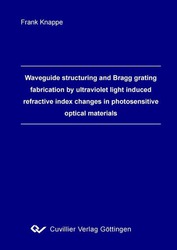| Departments | |
|---|---|
| Book Series (96) |
1378
|
| Nachhaltigkeit |
3
|
| Gesundheitswesen |
1
|
| Humanities |
2363
|
| Natural Sciences |
5406
|
| Engineering |
1791
|
| Engineering | 292 |
| Mechanical and process engineering | 861 |
| Electrical engineering | 686 |
| Mining and metallurgy | 30 |
| Architecture and civil engineering | 75 |
| Common |
98
|
|
Leitlinien Unfallchirurgie
5. Auflage bestellen |
|
Advanced Search
Waveguide structuring and Bragg grating fabrication by ultraviolet light induced refractive index changes in photosensitive optical materials (English shop)
Frank Knappe (Author)Preview
Table of Contents, Datei (38 KB)
Extract, Datei (76 KB)
The refractive index of photosensitive optical materials can be permanently changed by UV-irradiation. The objective of this thesis was to use such refractive index changes for the fabrication of waveguides and Bragg gratings.
Integrated optics allows for the integration of optical functionality on a small footprint. A technique to realize integrated optical waveguides is the direct writing technique where a focused UV-laser is scanned over a photosensitive sample. This fabrication method is of particular interest as no mask technology is involved, which is advantageous during the prototyping phase of new devices. UV-induced refractive index changes in excess of 10×10-3 were achieved in hydrogen-loaded germanium-doped silica layers and employed to fabricate straight waveguides, S-bends, directional couplers and multi-mode interference couplers. In one of the tested material systems the refractive index was decreased by the UV-irradiation rather than increased. Without any presensitization refractive index changes down by -10×10-3 were observed. Waveguides were realized in this material system by the negative direct writing technique, i.e. the waveguide cladding instead of the core was written. The fabrication of waveguide structures by UV-induced refractive index changes is not limited to layered material systems as described so far. Directly UV-written buried X-shaped waveguides in a bulk multicomponent silicate glass have been produced by a special X-shaped writing geometry. As an example for the use of UV-induced refractive index changes for the post processing of optical devices the crosstalk in an arrayed waveguide grating was significantly reduced.
Bragg gratings play a crucial role in modern optical communication systems. One interesting application area is the use as narrow-band channel filters in add/drop-multiplexers, where low chromatic dispersion values in reflection and transmission are required. Different design procedures were employed for the design of such Bragg grating structures. An optimization algorithm allowed for the consideration of constraints imposed by the writing facility which is later used for the fabrication. The designed Bragg gratings were fabricated afterwards by using a holographic writing setup which enables full control over local grating strength and period.
| ISBN-13 (Printausgabe) | 3867274142 |
| ISBN-13 (Hard Copy) | 9783867274142 |
| ISBN-13 (eBook) | 9783736924147 |
| Final Book Format | A5 |
| Language | English |
| Page Number | 174 |
| Edition | 1 |
| Volume | 0 |
| Publication Place | Göttingen |
| Place of Dissertation | Hamburg-Harburg |
| Publication Date | 2007-11-12 |
| General Categorization | Dissertation |
| Departments |
Electrical engineering
|
| Keywords | integrated optics, UV photosensitivity, UV writing, UV trimming, Bragg gratings. |








